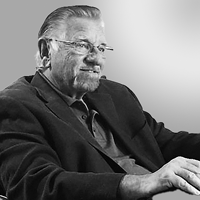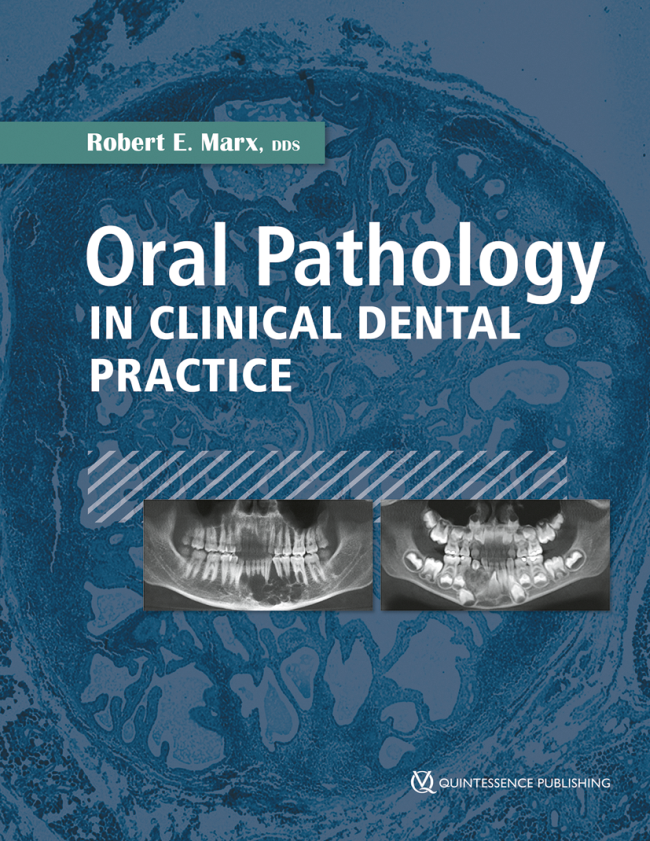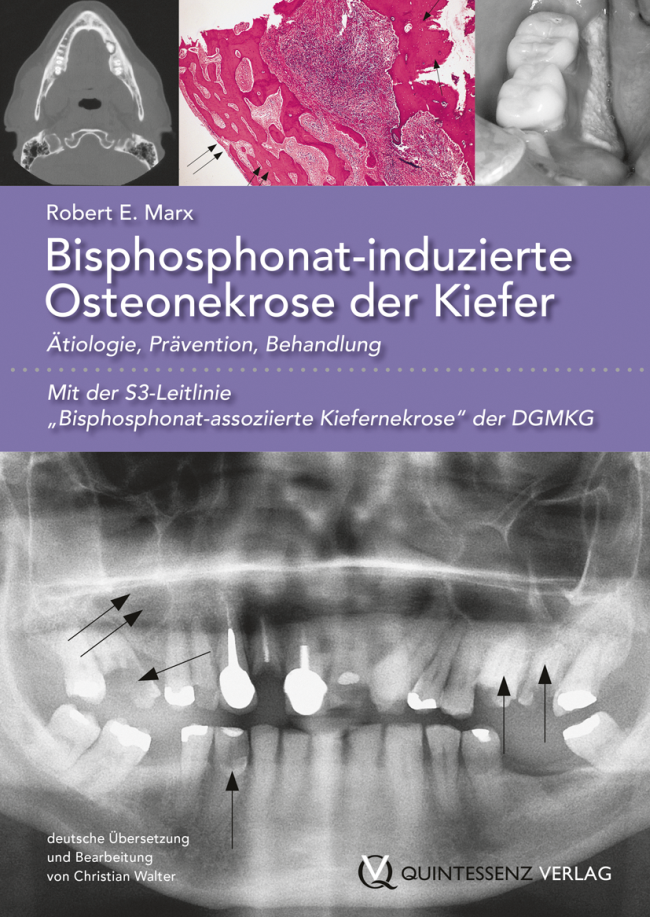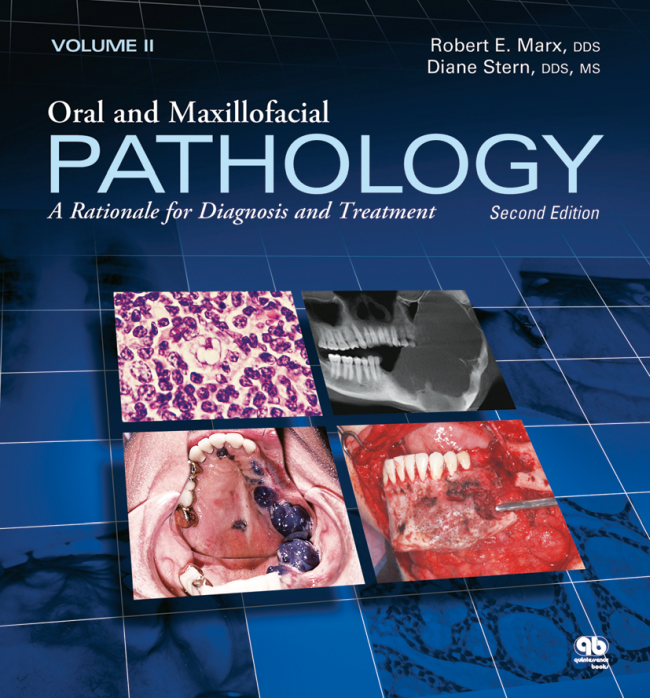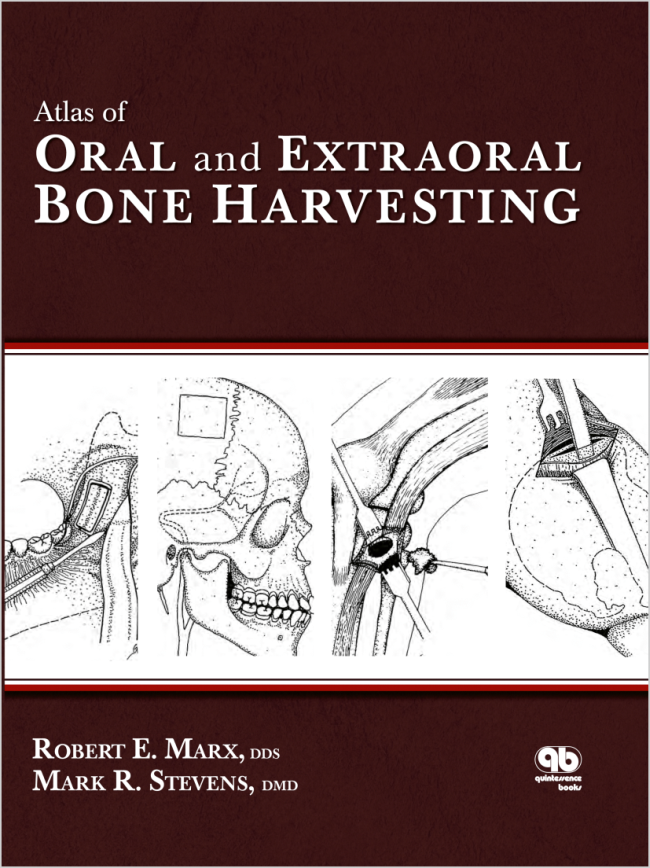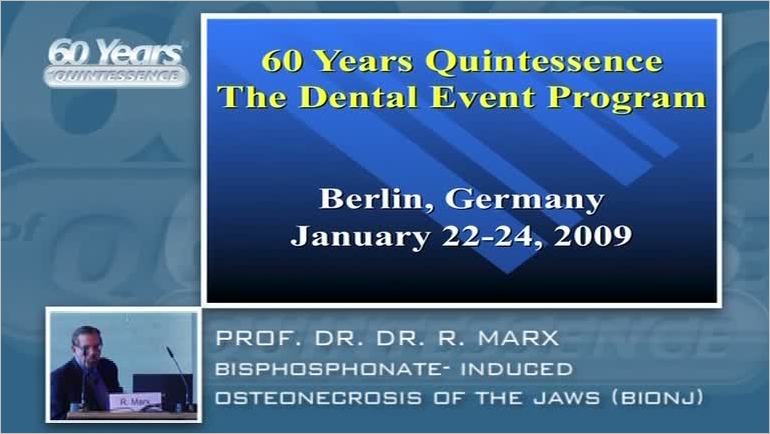The International Journal of Oral & Maxillofacial Implants, 2/2014
Online OnlyDOI: 10.11607/jomi.te56, PubMed-ID: 24683583Seiten: 201-209, Sprache: EnglischMarx, Robert E. / Harrell, David B.Purpose: This study investigated the role of the bone marrow-derived CD34+ cell in a milieu of osteoprogenitor cells, bone marrow plasma cell adhesion molecules, recombinant human bone morphogenetic protein (rhBMP), and a matrix of crushed cancellous allogeneic bone in the clinical regeneration of functionally useful bone in craniomandibular reconstructions. The history and current concepts of bone marrow hematopoietic stem cells and mesenchymal stem cells are reviewed as they relate to bone regeneration in large continuity defects of the mandible.
Materials and Methods: Patients with 6- to 8-cm continuity defects of the mandible with retained proximal and distal segments were randomized into two groups. Group A received an in situ tissue-engineered graft containing 54 ± 38 CD34+ cells/mL along with 54 ± 38 CD44+, CD90+, and CD105+ cells/mL together with rhBMP-2 in an absorbable collagen sponge (1 mg/cm of defect) and crushed cancellous allogeneic bone. Group B received the same graft, except the CD34+ cell concentration was 1,012 ± 752 cells/mL. The results were analyzed clinically, radiographic bone density was measured in Hounsfield units (HU), and specimens were analyzed histomorphometrically.
Results: Forty patients participated (22 men and 12 women; mean age, 57 years). Eight of 20 group A patients (40%) achieved the primary endpoint of mature bone regeneration, whereas all 20 group B patients (100%) achieved the primary endpoint. CD34+ cell counts above 200/mL were associated with achievement of the primary endpoint. Bone density was lower in group A (424 ± 115 HU) than in group B (731 ± 98 HU). Group A bone showed a mean trabecular bone area of 36% ± 10%, versus 67% ± 13% for group B.
Conclusions: The CD34+ cell functions as a central signaling cell to mesenchymal stem cells and osteoprogenitor cells in bone regeneration. The mechanism of bone marrow-supported grafts requires a complete milieu to regenerate large quantities of functionally useful bone. CD34+ cell counts in a concentration of at least 200/mL in composite grafts are directly correlated to clinically successful bone regeneration.
Schlagwörter: bone regeneration, hematopoietic stem cells, mesenchymal stem cells, recombinant human bone morphogenetic protein
The International Journal of Oral & Maxillofacial Implants, 2/2014
Online OnlyDOI: 10.11607/jomi.te61, PubMed-ID: 24683588Seiten: 247-258, Sprache: EnglischMarx, Robert E.While the AIDS epidemic of the 1980s taught the medical and dental professions much about immune cells and the immune system's cellular relationships, the bisphosphonate-induced osteonecrosis epidemic of the past decade has taught these same professions much about bone turnover, bone cell cross talk, the response and functional relationship of bone cells to loading, and drug effects on cellular dynamic relationships. The present article explores the literature as well as both evidence- and experience-based data to discuss known bone pathologies and physiologic mechanisms as well as uncover new findings: (1) bone remodeling is the mechanism by which bone adapts to loading stresses, termed either bone modeling or Wolff's law, and it is also the mechanism for bone renewal; (2) osteoclastic bone resorption triggers bone renewal at a rate of about 0.7%/ day by its release of growth factors; (3) bisphosphonates prevent the renewal of old and injured bone, thus making it brittle and more likely to fracture over time; (4) bisphosphonates have a halflife in bone of 11 years because of their irreversible binding to bone via their central carbon atom; (5) when administered intravenously, bisphosphonate loads bone and accumulates in bone 142.8 times faster than when administered orally; (6) osteoclastic resorption of bisphosphonate-loaded bone results in osteoclast death in which the cell bursts, releasing the bisphosphonate molecules to reenter the local bone or bone marrow in a re-dosing effect; (7) endosteal osteoblasts are dependent on the osteoclastic resorption/growth factor release/new bone formation mechanism of bone renewal, whereas periosteal osteoblasts are not; and (8) it is likely that endosteal osteoblasts and periosteal osteoblasts have different cell membrane receptors and arise from separate embryologic niches.
Schlagwörter: bisphosphonates, bisphosphonate-induced osteonecrosis of the jaw, bone modeling, bone remodeling, bone resorption, osteoblasts, osteoclasts, osteoporosis
The International Journal of Oral & Maxillofacial Implants, 1/2014
Online OnlyDOI: 10.11607/jomi.te40, PubMed-ID: 24451886Seiten: 37-44, Sprache: EnglischMarx, Robert E.The randomized prospective double-blinded clinical trial (RCT) is accepted as Level I evidence and is highly regarded. However, RCTs that gained FDA approval of drugs such as Vioxx, Fen- Phen, and oral and intravenous bisphosphonates have proven to generate misleading results and have not adequately identified serious adverse reactions. The development, research, and clinical marketing of the oral and intravenous bisphosphonates can serve as a representative example for the deteriorated value of many of today's RCTs. The expected high value of RCTs is jeopardized by: (1) sponsorship that incorporates bias; (2) randomization that can select out an expected improved result or eliminate higher-risk individuals; (3) experimental design that can avoid recognition of serious adverse reactions; (4) blinding that can easily become unblinded by the color, shape, odor, or administration requirements of a drug; (5) definitions that can define an observation as something other than what it actually represents, or fail to define it as an adverse reaction; (6) labeling of retrospective data as a prospective trial by using adjudicators prospectively to look at retrospective data; (7) change of the length of study to avoid the longerterm adverse reaction from accumulation of drug or treatment effects; (8) ghost writing, as when drug company physicians or a hired corporation either edit or write the entire protocol and/or manuscript for publication. Such corruption of the well-intended properly conducted RCT should be viewed with a sense of outrage by practitioners and requires a restructuring of the levels of evidence accepted today.
Schlagwörter: intravenous bisphosphonates, oral bisphosphonates, randomized clinical trials
The International Journal of Oral & Maxillofacial Implants, 1/2014
Online OnlyDOI: 10.11607/jomi.te42, PubMed-ID: 24451888Seiten: 58, Sprache: EnglischMarx, Robert E.The International Journal of Oral & Maxillofacial Implants, 5/2013
Online OnlyDOI: 10.11607/jomi.te04, PubMed-ID: 24066341Seiten: 243-251, Sprache: EnglischMarx, Robert E. / Armentano, Lawrence / Olavarria, Alberto / Samaniego, JuanPurpose: This study compared the histologic parameters and outcomes of two types of grafts in large vertical maxillary defects: a composite graft of recombinant human bone morphogenetic protein-2/acellular collagen sponge (rhBMP-2/ACS), crushed cancellous freeze-dried allogeneic bone (CCFDAB), and platelet-rich plasma (PRP); and size-matched 100% autogenous grafts.
Materials and Methods: Twenty patients each were treated with a composite graft, which contained 1.05 mg rhBMP-2/ACS per two-tooth segment together with CCFDAB and PRP, or a 100% autogenous graft prior to implant placement. Grafting material was contained within a titanium mesh crib.
Results: Two grafts in each group were lost as a result of early mesh exposure and infection. Three grafts in each group developed a late exposure of the mesh that did not affect bone regeneration. The remaining 18 autogenous grafts all regenerated sufficient bone for implant restoration (100%), and 17 of 18 (97.4%) of the composite grafts regenerated sufficient bone for implant restoration. The autogenous grafts included 54% ± 10% of new viable bone but also included residual nonviable graft particles. The composite grafts contained 59% ± 12% viable new bone and no remaining nonviable bone particles. The composite grafting technique resulted in less blood loss and shorter surgical time but greater and longer-lasting edema. The costs of both grafts were nearly equal.
Conclusion: A composite graft of rhBMP-2/ACS-CCFDAB-PRP regenerates bone in large vertical ridge augmentations as predictably as 100% autogenous graft with less morbidity, equal cost, and more viable new bone formation without residual nonviable bone particles, but with more edema. This composite graft represents an in situ tissue engineering concept that is able to achieve results equivalent to autogenous grafts in large vertical ridge augmentations without donor bone harvesting.
The International Journal of Oral & Maxillofacial Implants, 5/2013
Online OnlyDOI: 10.11607/jomi.te10, PubMed-ID: 24066346Seiten: 290-294, Sprache: EnglischMarx, Robert E. / Tursun, RamzeyPurpose: The purpose of this article was to compare the yields of stromal multipotent stem cells (CD34+ and CD105+) and hematopoetic multipotent stem cells (CD44+) obtained from different areas via bone marrow aspiration (BMA).
Materials and Methods: Sixty 60-mL bone marrow aspirates were taken from the tibial plateau, the anterior ilium, and the posterior ilium using a single point-of-care BMA technique and a single BMA concentration (BMAC) device. A 1-mL portion of each sample was used to determine CD stem cell concentrations and the nucleated cell count. The remaining BMA was centrifuged to separate the more mature red blood cell precursors from the stem cells and then concentrate the latter into a BMAC. The BMAC yield of 10 mL was analyzed with flow cytometry and nucleated cell counts to derive a concentration factor for the BMAC.
Results: The yield of total nucleated cells was equal between the anterior and posterior ilium and more than twice that obtained from the tibial plateau. The CD44+ and CD105+ cell yields were also nearly equal between the anterior and posterior ilium but more than twice that of the tibial plateau; however, the ratios between the three different stem cell types in BMAC obtained from the different areas suggest varying potentials for tissue development.
Conclusions: The ilium is the preferred donor site for obtaining autologous stem cells at the point of care. The tibial plateau yielded only half as much bone marrow multipotent/progenitor stem cells as did the anterior and posterior ilium. The composition of the BMAC from each site suggests that the potential for differentiation into various cell types changes depending on the source of bone marrow, but that BMAC represents 6.5 ± 1.0 concentration factor from BMA.
The International Journal of Oral & Maxillofacial Implants, 5/2013
Online OnlyDOI: 10.11607/jomi.te12, PubMed-ID: 24066348Seiten: 304-309, Sprache: EnglischSawatari, Yoh / Marx, Robert E. / Perez, Victor L. / Parel, Jean-MarieThe modified osteo-odonto keratoprosthesis (MOOKP) is a biologic keratoprosthesis that is used to treat a severely scarred cornea. The procedure involves multiple stages, including the transplantation of buccal mucosa to the damaged ocular surface and the implantation of an osteo-odonto lamina with a mounted polymethylmethacrylate lens. Among the keratoprostheses currently available, the MOOKP has proven to be the most effective based on the number of patients who have undergone the procedure and the duration of documented follow-up. Upon successful biointegration of the osteo-odonto lamina, the keratoprosthesis is able to resist resorption, provide stability, and prevent bacterial invasion and epithelial ingrowth. The effectiveness of the MOOKP is dependent on the anatomic and physiologic characteristics of the dental tissues and periodontal ligament.
The International Journal of Oral & Maxillofacial Implants, 4/2008
PubMed-ID: 18807554Seiten: 587-588, Sprache: EnglischMarx, Robert E.International Journal of Periodontics & Restorative Dentistry, 1/2008
PubMed-ID: 18351197Seiten: 5-6, Sprache: EnglischMarx, Robert E.The International Journal of Oral & Maxillofacial Implants, 1/2007
PubMed-ID: 17340909Seiten: 146-153, Sprache: EnglischDello Russo, Nicholas M. / Jeffcoat, Marjorie K. / Marx, Robert E. / Fugazzotto, Paul A.The development of osteonecrotic lesions of the jaws has been described as being associated with the use of bisphosphonates. Although most clinical reports described the association between necrotic lesions and the use of this group of medications for the management of osseous lesions associated with malignancies such as multiple myeloma, metastatic breast cancer, or prostate cancer, there are reports of osteonecrosis in the jaws of patients who are using oral bisphosphonates to treat osteoporosis.
Given the number of patients taking this medication for the management of osteoporosis, it is obvious that the risks and benefits of the medication need to be clearly defined. Could you comment on the risks of oral bisphosphonate use toward the development of osteonecrotic lesions of the jaws? In addition, could you postulate on studies that may better define this risk?



